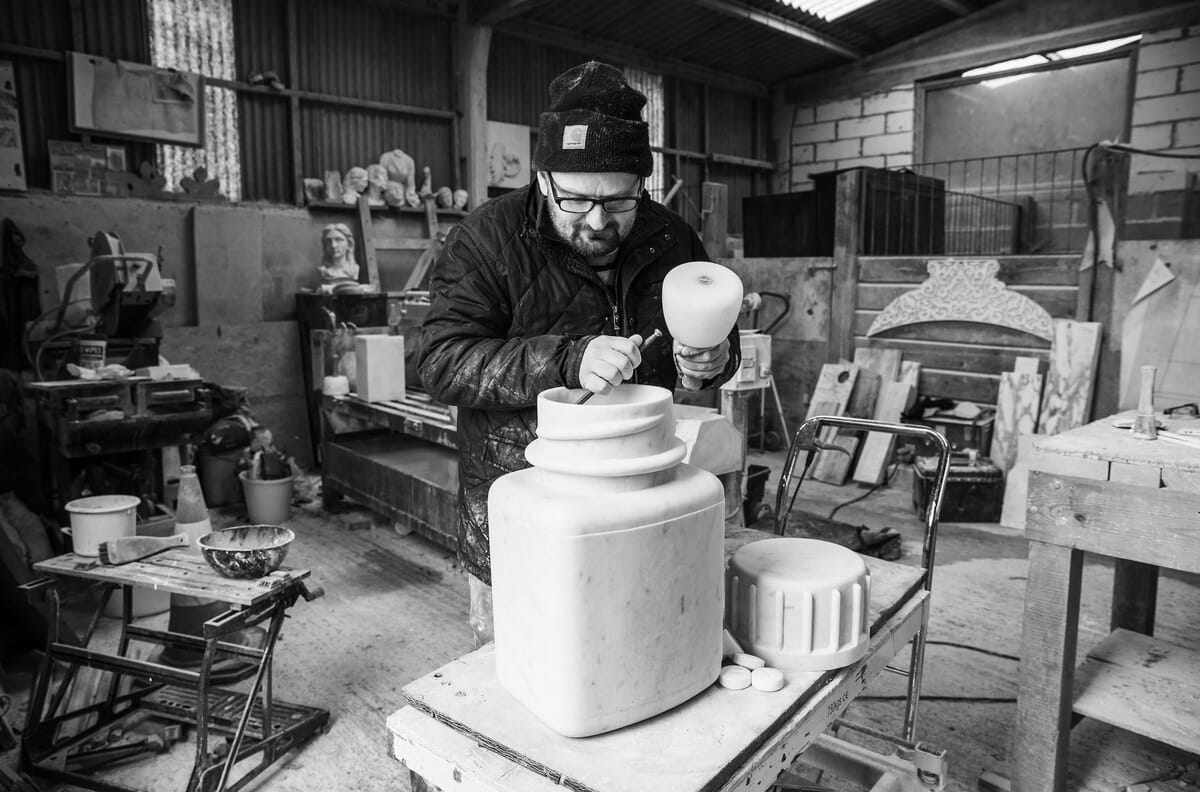
By juxtaposing the permanence of stone and marble with the transience of disposable objects, Waugh sparks an open and dissonant dialogue between piece and ponderer on consumerist culture, material value, and social norms.
By Sophie Heatley | 16 Jan 2025
When curating The Sound of Form exhibition, previous Rise Art Prize winner Tom Waugh immediately came to mind. If you’re unfamiliar with Waugh’s work, I highly recommend reading up on his practice and process. The sculptor transforms traditional materials, such as marble and stone, into hyper-realistic representations of ephemeral objects like cardboard boxes, blister packets, and plastic cups—the things we use once and then discard, oblivious to their ultimate destination as they pass from our hands to the eager, hungry mouths of our bins.

By juxtaposing the permanence of stone and marble with the transience of disposable objects, Waugh sparks an open and dissonant dialogue between piece and ponderer on consumerist culture, material value, and social norms.
It is hard not to be drawn into the immense sensory dimensions of Waugh’s work. The intricate details in his Anthropocene series preserve the fleeting imprints of human use, almost like fossils of our consumption. There is a documentary feel to each of his sculptures, ranging from crumpled ‘cardboard’ boxes to wheelie bins, without being factual or historical. They overtly challenge our understanding of waste culture without directly explaining anything at all– my favourite kind of intellectual confrontation, where you don’t realise you’re being provoked until you’re too deep in thought to turn back.

There is also an almost magnetic subtlety to their storytelling; each form carries a resonance that feels like a memory—perhaps of the things we, as consumers, have carelessly misused, underused, or left untouched, still in their packaging, before donating them to the local bin men. Out of sight, out of mind. The hyperrealism is… unreal. The dusty, rusty appearance of ironstone, the polished, manufactured sheen of white marble—expertly smoothed or encrusted by Waugh—are uncanny. It’s only when you move closer to the piece that you realise these aren’t discarded relics from yesteryear but exquisite representations.
“I love seeing the shift in perception when people engage with my work. When someone sees a cardboard box in a gallery, it often reinforces their prejudices about contemporary art. But then they touch it, interact with it, and realise it’s so much more than meets the eye. Something they thought was worthless suddenly becomes profound and takes on a new meaning; something valueless becomes incredibly significant.”

Size matters too. Larger-than-life works have a slightly different impact, blending the boldness of Pop Art with an unexpectedly Greek archaeological quality. By immortalising waste objects in materials of high value and amplifying their scale, his work transforms the mundane into the monumental. After viewing them, there is this strange moment when you can’t help but think: Wow, this is what the future ‘us,’ in the Year 3000, will be unearthing. Just as we’ve excavated The Rosetta Stone or, I don’t know, Knossos in Crete, imagining our ancestors’ reverence, they’ll dig up our rubbish and think we worshipped it, that we sacrificed ourselves for a plastic bag. And honestly, they wouldn’t be wrong. I love this tension—it’s eerie and endlessly fascinating.

Anyway, I digress. Yes, on observation, there is the memory it stirs. But then there is something else—equally neurological, perhaps, but more imaginatively stimulating: the sounds they seem to emit. It’s as if the pieces are saying, “Hello, it’s me, that plastic cup you thought you’d got rid of but actually just passed along for someone else to deal with.”
Waugh is no stranger to the terrifying waste mountains that accumulate across the globe—tidal waves of rubbish stretching endlessly across beaches, children scavenging scraps of metal, unwanted pens, and discarded parchments from last month’s waste spree, selling them to local makers. A quick asterisk moment: during university, Waugh spent time in India on an exchange programme, analysing and learning the traditional techniques of Indic carving, where he encountered some of these scenes.

But back to the sound. Stone and marble are, by nature, silent and enduring materials, yet Waugh’s works suggest a narrative—or even an imagined “sound”—through their subject matter. The rattle of pills in Big Pharma III, or the satisfying crunch of foil in Big Pharma. Wassily Kandinsky once said, “No matter how abstract, every form has its own inner sound.” Here, too, another tension: the physical, unyielding permanence of the piece contrasts with the sensory experience it conjures.
I feel this soundscape deeply when observing these works; the hum of all the things we’ve left behind or overlooked, coming back to haunt us. The silence of these ghostly remains speaks louder than words. Waugh doesn’t need to colour them with explanations, anyone with an ounce of empathy for the planet will feel a rumble of guilt, of unease, the echo of something needing to change before it’s too late.
You can see works by Tom Waugh until April 2025 via our virtual gallery as part of our latest showcase, The Sound of Form.







